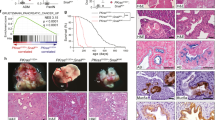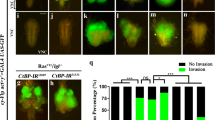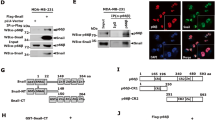Abstract
Lethal giant larvae proteins have key roles in regulating polarity in a variety of cell types and function as tumour suppressors. A transcriptional programme initiated by aberrant Snail expression transforms epithelial cells to potentially aggressive cancer cells. Although progress in defining the molecular determinants of this programme has been made, we have little knowledge as to how the Snail-induced phenotype can be suppressed. In our studies we identified the human lethal giant larvae homologue 2, Hugl-2, (Llgl2/Lgl2) polarity gene as downregulated by Snail. Snail binds E-boxes in the Hugl-2 promoter and represses Hugl-2 expression, whereas removal of the E-boxes releases Hugl-2 from Snail repression. We demonstrate that inducing Hugl-2 in cells with constitutive Snail expression reverses the phenotype including changes in morphology, motility, tumour growth and dissemination in vivo, and expression of epithelial markers. Hugl-2 expression reduced the nuclear localization of Snail and thus binding of Snail to its target promoters. Our results placing Hugl-2 within the Snail network as well as its ability to suppress Snail carcinogenesis identifies Hugl-2 as a target molecule driving cascades, which may have preventative and therapeutic promise to minimize cancer progression.
This is a preview of subscription content, access via your institution
Access options
Subscribe to this journal
Receive 50 print issues and online access
$259.00 per year
only $5.18 per issue
Buy this article
- Purchase on Springer Link
- Instant access to full article PDF
Prices may be subject to local taxes which are calculated during checkout






Similar content being viewed by others
References
Gateff E, Schneiderman HA . Developmental studies of a new mutant of Drosophila melanogaster: Lethal malignant brain tumor (l(2)gl 4). Am Zool 1967; 7: 760.
Mechler BM, McGinnis W, Gehring WJ . Molecular cloning of lethal(2)giant larvae, a recessive oncogene of Drosophila melanogaster. EMBO J 1985; 4: 1551–1557.
Albertson R, Doe CQ . Dig, Scrib and Lgl regulate neuroblast cell size and mitotic spindle asymmetry. Nat Cell Biol 2003; 5: 166–170.
Betschinger J, Mechtler K, Knoblich JA . The Par complex directs asymmetric cell division by phosphorylating the cytoskeletal protein Lgl. Nature 2003; 422: 326–330.
Bilder D . Epithelial polarity and proliferation control: links from the Drosophila neoplastic tumor suppressors. Genes Dev 2004; 18: 1909–1925.
Froldi F, Ziosi M, Tomba G, Parisi F, Garoia F, Pession A et al. Drosophila lethal giant larvae neoplastic mutant as a genetic tool for cancer modeling. Curr Genomics 2008; 9: 147–154.
Lee M, Vasioukhin V . Cell polarity and cancer–cell and tissue polarity as a non-canonical tumor suppressor. J Cell Sci 2008; 121: 1141–1150.
Grifoni D, Garoia F, Schimanski CC, Schmitz G, Laurenti E, Galle PR et al. The human protein Hugl-1 substitutes for Drosophila Lethal giant larvae tumour suppressor function in vivo. Oncogene 2004; 23: 8688–8694.
Kuphal S, Wallner S, Schimanski CC, Bataille F, Hofer P, Strand S et al. Expression of Hugl-1 is strongly reduced in malignant melanoma. Oncogene 2006; 25: 103–110.
Grifoni D, Garoia F, Bellosta P, Parisi F, De Biase D, Collina G et al. aPKCzeta cortical loading is associated with Lgl cytoplasmic release and tumor growth in Drosophila and human epithelia. Oncogene 2007; 26: 5960–5965.
Schimanski CC, Schmitz G, Kashyap A, Bosserhoff AK, Bataille F, Schafer SC et al. Reduced expression of Hugl-1, the human homologue of Drosophila tumour suppressor gene lgl, contributes to progression of colorectal cancer. Oncogene 2005; 24: 3100–3109.
Lisovsky M, Dresser K, Baker S, Fisher A, Woda B, Banner B et al. Cell polarity protein Lgl2 is lost or aberrantly localized in gastric dysplasia and adenocarcinoma: an immunohistochemical study. Mod Pathol 2009; 22: 977–984.
Tsuruga T, Nakagawa S, Watanabe M, Takizawa S, Matsumoto Y, Nagasaka K et al. Loss of Hugl-1 expression associates with lymph node metastasis in endometrial cancer. Oncol Res 2007; 16: 431–435.
Lu X, Feng X, Man X, Yang G, Tang L, Du D et al. Aberrant splicing of Hugl-1 is associated with hepatocellular carcinoma progression. Clin Cancer Res 2009; 15: 3287–3296.
Lisovsky M, Dresser K, Woda B, Mino-Kenudson M . Immunohistochemistry for cell polarity protein lethal giant larvae 2 differentiates pancreatic intraepithelial neoplasia-3 and ductal adenocarcinoma of the pancreas from lower-grad pancreatic intraepithelial neoplasias. Hum Pathol 2010; 41: 902–909.
Singh A, Greninger P, Rhodes D, Koopmean L, Violette S, Bardeesy N et al. A gene expression signature associated with ‘K-Ras addiction’. Cancer Cell 2009; 15: 489–500.
Dahiya N, Sherman-Baust CA, Wang T, Davidson B, Shih L, Zhang Y et al. MicroRNA expression and identification of putative miRNA targets in ovarian cancer. PLoS ONE 2008; 3: 1–11.
Gaspar C, Cardoso J, Franken P, Molenaar L, Morreau H, Moslein G et al. Cross-species comparison of human and mouse intestinal polyps reveals conserved mechanisms in adenomatous polyposis coli (APC)-driven tumorigenesis. Am J Pathol 2008; 172: 1363–1380.
Harada T, Chelala C, Crnogorac-Jurcevic T, Lemoine NR . Genome-wide analysis of pancreatic cancer using microarray-based techniques. Pancreatology 2009; 9: 13–24.
Hensen EF, De Herdt MJ, Goeman JJ, Oosting J, Smit VT, Cornelisse CJ et al. Gene-expression of metastasized versus non-metastasized primary head and neck squamous cell carcinomas: a pathway-based analysis. BMC Cancer 2008; 8: 168.
Huang E, Cheng SH, Dressman H, Pittman J, Tsou MH, Horng CF et al. Gene expression predictors of breast cancer outcomes. Lancet 2003; 361: 1590–1596.
Lassmann S, Weis R, Makowiec F, Roth J, Danciu M, Hopt U et al. Array CGH identifies distinct DNA copy number profiles of oncogenes and tumor suppressor genes in chromosomal- and microsatellite-unstable sporadic colorectal carcinomas. J Mol Med 2007; 85: 293–304.
Maas K, Chan S, Parker J, Slater A, Moore J, Olsen N et al. Cutting edge: molecular portrait of human autoimmune disease. J Immunol 2002; 169: 5–9.
Ohali A, Avigad S, Zaizov R, Ophir R, Horn-Saban S, Cohen IJ et al. Prediction of high risk Ewing's sarcoma by gene expression profiling. Oncogene 2004; 23: 8997–9006.
Roepman P, Wessels LF, Kettelarij N, Kemmeren P, Miles AJ, Lijnzaad P et al. An expression profile for diagnosis of lymph node metastases from primary head and neck squamous cell carcinomas. Nat Genet 2005; 37: 182–186.
Singh A, Greninger P, Rhodes D, Koopman L, Violette S, Bardeesy N et al. A gene expression signature associated with ‘K-Ras addiction’ reveals regulators of EMT and tumor cell survival. Cancer Cell 2009; 15: 489–500.
Skotheim RI, Monni O, Mousses S, Fossa SD, Kallioniemi OP, Lothe RA et al. New insights into testicular germ cell tumorigenesis from gene expression profiling. Cancer Res 2002; 62: 2359–2364.
Taxman DJ, MacKeigan JP, Clements C, Bergstralh DT, Ting JP . Transcriptional profiling of targets for combination therapy of lung carcinoma with paclitaxel and mitogen-activated protein/extracellular signal-regulated kinase kinase inhibitor. Cancer Res 2003; 63: 5095–5104.
Tomioka H, Morita K, Hasegawa S, Omura K . Gene expression analysis by cDNA microarray in oral squamous cell carcinoma. J Oral Pathol Med 2006; 35: 206–211.
Vekony H, Ylstra B, Wilting SM, Meijer GA, van de Wiel MA, Leemans CR et al. DNA copy number gains at loci of growth factors and their receptors in salivary gland adenoid cystic carcinoma. Clin Cancer Res 2007; 13: 3133–3139.
Zavadil J . Bitzer M, Liang D, Yang YC, Massimi A, Kneitz S, et al. Genetic programs of epithelial cell plasticity directed by transforming growth factor-beta. Proc Natl Acad Sci USA 2001; 98: 6686–6691.
Acloque H, Adams MS, Fishwick K, Bronner-Fraser M, Nieto MA . Epithelial-mesenchymal transitions: the importance of changing cell state in development and disease. J Clin Invest 2009; 119: 1438–1449.
Gavert N, Ben-Ze'ev A . Epithelial-mesenchymal transition and the invasive potential of tumors. Trends Mol Med 2008; 14: 199–209.
Thiery JP, Acloque H, Huang RY, Nieto MA . Epithelial-mesenchymal transitions in development and disease. Cell 2009; 139: 871–890.
Arumugam T, Ramachandran V, Fournier KF, Wang H, Marquis L, Abbruzzese JL et al. Epithelial to mesenchymal transition contributes to drug resistance in pancreatic cancer. Cancer Res 2009; 69: 5820–5828.
Kajita M, McClinic KN, Wade PA . Aberrant expression of the transcription factors snail and slug alters the response to genotoxic stress. Mol Cell Biol 2004; 24: 7559–7566.
Pena C, Garcia JM, Larriba MJ, Barderas R, Gomez I, Herrera M et al. SNAI1 expression in colon cancer related with CDH1 and VDR downregulation in normal adjacent tissue. Oncogene 2009; 28: 4375–4385.
Batlle E, Sancho E, Franci C, Dominguez D, Monfar M, Baulida J et al. The transcription factor snail is a repressor of E-cadherin gene expression in epithelial tumour cells. Nat Cell Biol 2000; 2: 84–89.
Cano A, Perez-Moreno MA, Rodrigo I, Locascio A, Blanco MJ, del Barrio MG et al. The transcription factor snail controls epithelial-mesenchymal transitions by repressing E-cadherin expression. Nat Cell Biol 2000; 2: 76–83.
Nieto MA . The snail superfamily of zinc-finger transcription factors. Nat Rev Mol Cell Biol 2002; 3: 155–166.
Peinado H, Olmeda D, Cano A . Snail, Zeb and bHLH factors in tumour progression: an alliance against the epithelial phenotype? Nat Rev Cancer 2007; 7: 415–428.
Aigner K, Dampier B, Descovich L, Mikula M . Sultan A, Schreiber M, et al. The transcription factor ZEB1 (deltaEF1) promotes tumour cell dedifferentiation by repressing master regulators of epithelial polarity. Oncogene 2007; 26: 6979–6988.
Spaderna S, Schmalhofer O, Wahlbuhl M, Dimmler A, Bauer K . Sultan A, et al. The transcriptional repressor ZEB1 promotes metastasis and loss of cell polarity in cancer. Cancer Research 2008; 68: 537–544.
Moreno-Bueno G, Portillo F, Cano A . Transcriptional regulation of cell polarity in EMT and cancer. Oncogene 2008; 27: 6958–6969.
Blanco MJ, Moreno-Bueno G, Sarrio D, Locascio A, Cano A, Palacios J et al. Correlation of Snail expression with histological grade and lymph node status in breast carcinomas. Oncogene 2002; 21: 3241–3246.
Moody SE, Perez D, Pan TC, Sarkisian CJ, Portocarrero CP, Sterner CJ et al. The transcriptional repressor Snail promotes mammary tumor recurrence. Cancer Cell 2005; 8: 197–209.
Miyoshi A, Kitajima Y, Kido S, Shimonishi T, Matsuyama S, Kitahara K et al. Snail accelerates cancer invasion by upregulating MMP expression and is associated with poor prognosis of hepatocellular carcinoma. Br J Cancer 2005; 92: 252–258.
Klezovitch O, Fernandez TE, Tapscott SJ, Vasioukhin V . Loss of cell polarity causes severe brain dysplasia in Lgl1 knockout mice. Genes Dev 2004; 18: 559–571.
Moreno-Bueno G, Salvador F, Martin A, Floristan A, Cuevas EP, Santos V et al. Lysyl oxidase-like 2 (LOXL2), a new regulator of cell polarity required for metastatic dissemination of basal-like breast carcinomas. EMBO Mol Med 2011; 3: 1–17.
Brown CJ, Lain S, Verma CS, Fersht AR, Lane DP . Awakening guardian angels: drugging the p53 pathway. Nat Rev Cancer 2009; 9: 862–873.
Aichberger KJ, Gleixner KV, Mirkina I, Cerny-Reiterer S, Peter B, Ferenc V et al. Identification of proapoptotic Bim as a tumour suppressor in neoplastic mast cells: role of KIT D816V and effects of various targeted drugs. Blood 2009; 114: 5342–5351.
Hajra KM, Ji X, Fearon ER . Extinction of E-cadherin expression in breast cancer via a dominant repression pathway acting on proximal promoter elements. Oncogene 1999; 18: 7274–7279.
Acknowledgements
We thank A Garcia de Herreros for allowing us to use the Snail-HA expression plasmid and PH Krammer for providing anti-Apo-1 antibody. MDA-MB-231 cells were a gift of Thomas Efferth. We kindly thank Anil K Rustgi and Eric R Fearon for providing CyclinD1- and E-cadherin-luciferase constructs, respectively. The expert technical assistance of Mirjam Weisser, Daniela Gottfried, Henry Alizor, Shenchu Jin and Henning Janssen is gratefully acknowledged. Special thanks to the laser-scanning microscopy Core Facility of the Forschungszentrum Immunolgie Mainz. This work was supported by grants from the MAIFOR program to DS and SS. DS and SS should be considered as equal senior authors.
Author information
Authors and Affiliations
Corresponding author
Ethics declarations
Competing interests
The authors declare no conflict of interest.
Additional information
Supplementary Information accompanies the paper on the Oncogene website
Rights and permissions
About this article
Cite this article
Kashyap, A., Zimmerman, T., Ergül, N. et al. The human Lgl polarity gene, Hugl-2, induces MET and suppresses Snail tumorigenesis. Oncogene 32, 1396–1407 (2013). https://doi.org/10.1038/onc.2012.162
Received:
Revised:
Accepted:
Published:
Issue Date:
DOI: https://doi.org/10.1038/onc.2012.162
Keywords
This article is cited by
-
Rewiring cell polarity signaling in cancer
Oncogene (2015)
-
Deregulation of the cell polarity protein Lethal giant larvae 2 (Lgl2) correlates with gastric cancer progression
Gastric Cancer (2014)



